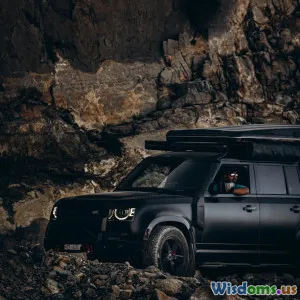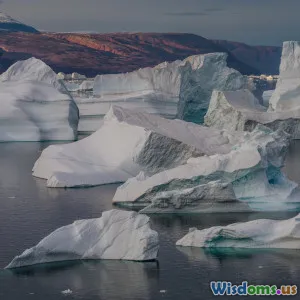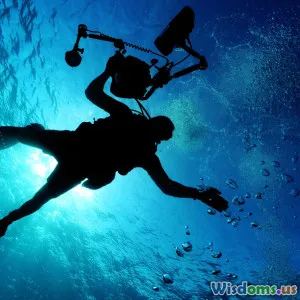
How to Select the Right Travel Insurance for Explorers
18 min read A practical guide for explorers on choosing ideal travel insurance tailored to adventurous journeys and unique needs. (0 Reviews)
How to Select the Right Travel Insurance for Explorers
For avid explorers, every journey promises adventure, wonder, and occasionally, the unexpected. While scaling peaks in Nepal or diving off the coast of Australia, even the most experienced traveler realizes that uncertainty is part of the thrill. That’s why travel insurance isn’t just a checkbox on your trip-planning to-do list—it’s your essential safety net. But with a global maze of plans and providers, selecting the right travel insurance can seem overwhelming. In this comprehensive guide, you'll discover how to pinpoint the right coverage for your unique adventures, with practical examples and insider tips along the way.
Why Explorers Need Specialized Travel Insurance

Unlike the average vacationer, explorers are more likely to encounter offbeat circumstances: remote destinations, adrenaline-fueled activities, or unfamiliar terrain. This introduces a higher level of risk that standard travel insurance may not effectively cover.
- Extreme Activities Require Extra Coverage: A comprehensive insurance policy for explorers will often include protection for trekking above certain altitudes, scuba diving, bungee jumping, or other adventurous pursuits. Take Maria, for example, who had to be medically evacuated from a Himalayan trail—her specialized adventure policy covered helicopter rescue, saving her over $12,000.
- Remote Destinations Pose Unique Challenges: Traveling to places with limited medical facilities or political instability needs coverage like emergency evacuation, political unrest protection, or coverage during natural disasters. Policies marketed to explorers frequently offer all this and more.
Key Takeaway: Read beyond the brochure gloss—explorers should ensure their plan accounts for every activity and region on their itinerary.
Key Coverage Elements Every Explorer Should Consider

It’s a myth that all travel insurance offers the same protection. Instead, coverage varies greatly, especially regarding adventurous pursuits and far-flung regions. Here are crucial features intrepid travelers should demand:
1. Medical Emergencies and Evacuation
Standard travel insurance may limit coverage for medical evacuation—which can cost tens of thousands of dollars from a remote area—or even for treatment related to high-risk activities. Confirm your policy:
- Covers accidents during adventure sports or trekking/climbing above certain altitudes.
- Includes air ambulance and medical repatriation for emergencies in remote locations.
2. Trip Cancellation and Interruption
Explorers often invest considerably in non-refundable expeditions, tours, and flight segments:
- Look for robust coverage that reimburses prepaid expenses if you must cancel due to injury, illness, natural disaster, or even an operator’s insolvency.
- Some providers offer “cancel for any reason” upgrades.
3. Baggage and Gear Protection
Your adventure can come to a halt if your specialist equipment—be it climbing ropes or diving computers—is damaged or stolen. Ensure the policy:
- Offers high-value coverage for electronics, sports gear, and specialty equipment.
- Includes replacement or repair during your trip so your exploration isn’t ruined.
4. Coverage for Political Unrest or Natural Disasters
In remote or rapidly-changing regions, situations on the ground can shift unexpectedly:
- Select a plan that provides trip curtailment due to political upheaval or evacuation assistance in case of natural calamity.
Example: During the eruption of Mount Agung in Bali, travelers with comprehensive cover were able to claim for interrupted plans and emergency flights, while those on basic policies were left stranded.
Comparing Travel Insurance Providers for Adventurers

Not all insurance companies are created equal, particularly when it comes to explorer-friendly coverage. Comparing providers is a must.
How to Analyze Policies Side-by-Side
Create a simple spreadsheet with policy benefits across these categories:
| Feature | Insurer A | Insurer B | Insurer C |
|---|---|---|---|
| Activity Coverage | Yes (up to 6,000m) | No | Yes (all activities) |
| Medical Evacuation | $1M | $100k | $500k |
| Gear Replacement | $3,000 | $1,000 | $2,500 |
| Cancel for Any Reason | Yes | No | Add-on |
| 24/7 Assistance | Yes | Limited hours | Yes |
| Optional Add-ons | Extreme sports | None | Political evacuation |
Some of the most reputed providers for explorers include:
- World Nomads: Broad coverage for adventure sports and flexible extension options.
- Allianz Global Assistance: Great for medical coverage and 24/7 assistance.
- IMG: Known for robust medical evacuation from remote areas.
User Reviews and Claim Experience
Dig into user feedback on forums or travel blogs. Providers vary widely in how efficiently they handle claims. Fast, responsive customer support from a company that specializes in adventurous travel is a true differentiator.
Tip: Reach out to fellow explorers on platforms like Reddit’s r/AdventureTravel for anecdotal evidence on policy payouts and real-world assistance.
Adventure Activities: What’s Usually Excluded?

Even policies designed for explorers have limits! Understanding common exclusions helps you avoid nasty surprise denials.
Common Exclusions in Adventure Policies
- Certain Extreme Sports: Skydiving, motorbiking above certain engine sizes, or mountaineering above specified heights may be excluded or require specifically-named endorsements.
- Professional or Competitive Events: Competing (as opposed to recreational participation) often falls outside standard cover.
- Alcohol & Recklessness: Claims for injuries sustained while under the influence or after disregarding local safety laws are almost universally excluded.
- Personal Belongings Restrictions: Some policies cap coverage on expensive personal effects—like laptops, satellite phones, or drones.
Example: James went whitewater rafting in Costa Rica; after dislocating his shoulder, his claim was denied because his insurer specifically excluded any water sport above Class III rapids.
Advice: Always review the fine print and ask for written confirmation from the insurer if you are planning something "off the beaten path."
Evaluating Medical Coverage for Global Treks

For explorers, medical coverage is about more than just hospital bills—it can mean organizing emergency evacuation, translation services, or repatriation in worst-case scenarios.
Altitude and Terrain: Crucial Factors
- Trekking/Hiking: Medical insurance often covers trekking up to a comfortable 3,000m, but peaks like Kilimanjaro (5,895m) or Everest Base Camp (5,364m) require policies with extended altitude triggers.
- Remote Environments: Ensure that you're covered for contingencies like snake bites, tropical illnesses, or altitude sickness where facilities may be days away.
Emergency Evacuation: The Hidden Lifesaver
- Mechanical or Air Rescue: Policies should specify helicopter/air ambulance coverage for remote extraction.
- Coverage Limitation Example: Some policies only refund ground ambulance costs, not the expensive aerial rescues necessary for places like the Andes or Central Asia.
Practical Tip: Always share your policy’s emergency assistance number with your travel companions and local guides, and store digital and hard copies.
Duration, Multi-Trip, and Flexible Policies for Frequent Explorers

One-off city breaks need a different insurance approach than a multi-month South American adventure or frequent globetrotter lifestyle.
Which Type Suits You?
- Single Trip Policies: Ideal for one-off, planned expeditions shorter than 90 days.
- Multi-Trip or Annual Policies: Perfect for explorers on back-to-back journeys throughout a year—can save hundreds if traveling more than thrice annually.
- Long Stay and Flexible Coverage: Useful for digital nomads, round-the-world (RTW) ticket holders, or those who tweak destinations on the fly.
Example: Amanda, who split her year between cycling in Patagonia and river kayaking in Southeast Asia, found a 12-month flex policy—covering all planned and impromptu adventures—saved her over $600 compared to repeated one-off plans.
Be sure to check:
- Maximum days per trip (even with annual cover)
- Specific country exclusions
- Flexibility for extensions while already abroad (critical for explorers who extend adventures)
Insurance for Expeditions Involving Uncommon Risks

If you’re planning journeys beyond mainstream adventure—think Arctic expeditions, desert crossings, or remote island survival courses—off-the-shelf travel insurance may not be enough.
What to Ask When Organizing High-Risk Journeys
- Geographical coverage: Will your insurer cover polar regions, conflict zones, or sailing across international waters?
- Support coordination: Does the company have prior experience handling emergencies in remote environments—with satellite phone coordination or evacuation logistics?
- Evacuation partners: Who are their partners on the ground—local hospitals, airlift companies, consulates?
Notable Example: The 2019 Greenland polar traverse saw multiple evacuations; specialized insurance arranged airlifts despite blizzard-induced airport closures, a feat not managed by mainstream providers.
When in doubt, consult specialist brokers who routinely handle expedition insurance for explorers, filmmakers, and large guided teams.
Insider Tips and Cost-Saving Hacks for Explorer Insurance

Adventure doesn’t have to come with a budget-breaking premium. Here’s how seasoned explorers keep protection robust without wasting money:
1. Shop Early and Compare Extensively
Lock in coverage as soon as you put down a deposit. “Cancel for any reason” coverage often only applies if purchased within days of initial trip payments.
2. Only Buy What You Need
Customize: Don’t pay for rental car collision if you’re cycling the Silk Road. Remove irrelevant add-ons; negotiate for adventure sports endorsements instead.
3. Consider Group Policies
Expedition teams or traveling pairs can score discounts with group plans—and ensure everyone’s coverage is consistent.
4. Maximize Coverage Through Credit Cards
Many high-end cards include basic travel protection—combine with a top-up adventure sports policy for optimal savings.
5. Document Everything
Keep all receipts, itineraries, operator records, and a summary of communications. Quick claim resolution favors those with organized, documented proof.
Pro-Tip: Use digital vault apps or cloud storage for backup access wherever your journeys lead.
How Real-Life Explorers Learned the Hard Way

Stories abound from real-world wanderers who benefited—or suffered—based on their insurance choices:
- The Antarctic Sea Kayaker: A Dutch explorer saved $19,000 by having a tailored policy that covered cold-water rescue and post-evacuation care after hypothermia interrupted her kayak expedition.
- The Amazon Cyclist: Without jungle disease add-ons, a cyclist had to crowdfund treatment for a rare infection. The right supplemental insurance would have covered both evacuation and care.
What’s the Lesson? Betting on luck isn’t a sound safety strategy. Listening to first-hand explorer testimonials points to the need for honest, granular insurance checks.
Checklist: Questions to Ask Before Purchasing Travel Insurance

Use these targeted questions before booking your next trip:
- What’s the maximum coverage for medical bills, evacuation, and adventurous activities?
- Is altitude, remoteness, or region a restriction for any coverage?
- Does the policy cover trip cancellation or interruption for any reason important to me?
- What are gear/equipment reimbursement limits?
- Are political unrest or natural disaster evacuations included?
- What’s the process and timeline for filing and resolving a claim overseas?
- Is there a 24/7 local-language helpline?
- Can I extend or renew my coverage while abroad?
Take time to get written answers—never assume!
Forge Ahead with Peace of Mind

Intrepid explorers chase the thrill of the unknown, but every seasoned traveler knows the smartest journeys are planned with caution and care. By choosing a robust, tailored travel insurance plan, you focus on forging unforgettable memories, not worrying about sudden mishaps. With the right questions, sensible comparisons, and a keen eye for detail, your wanderlust can run free—confident that you’re protected wherever the map may lead. Safe travels!
Rate the Post
User Reviews
Popular Posts














